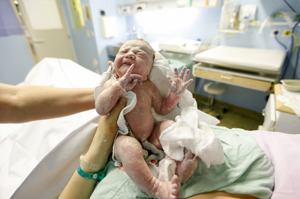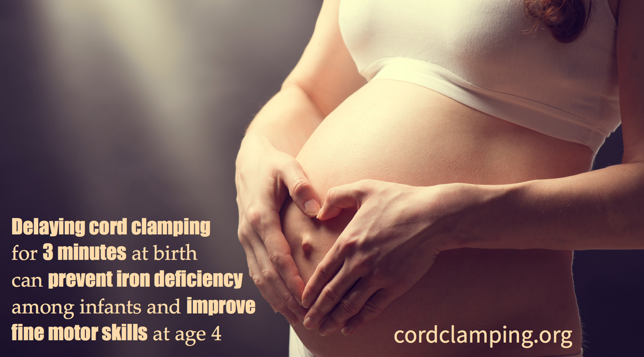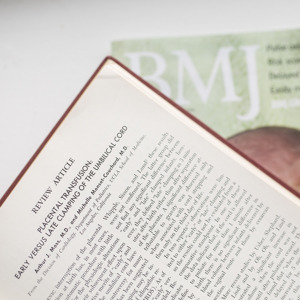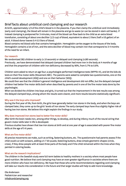2015
Frédérick Leboyer M.D. was an obstetrician who was a predecessor in exploring advantages with uninterventional child birth. He's description of birth fits well with my experiences and the results from our research. Read what he had to say about the transition from being dependent of the placenta to start breathing by it's own:
Birth Without Violence (first published in 1974)
By Frederick Leboyer M.D
This is a citation from the Facebook page: Leaving A Baby's Umbilical Cord To Stop Pulsating (Delayed Cord Clamping)
"She [ Mother nature] has arranged it so that during the dangerous passage of birth, the child is receiving oxygen from two sources rather than one: from the lungs and from the umbilicus. Two systems functioning simultaneously, one relieving the other: the old one, the umbilicus, continues to supply oxygen to the baby until the new one, the lungs, has fully taken its place. However, once the infant has been born and delivered from the mother, it remains bound to her by this umbilicus, which continues to beat for several long minutes: four . . . five .. . sometimes more. Oxygenated by the umbilicus, sheltered from anoxia, the baby can settle into breathing without danger and without shock. At leisure. .. . In addition, the blood has plenty of time to abandon its old route (which leads to the placenta) and progressively to fill the pulmonary circulatory system. During this time, in parallel fashion, an orifice closes in the heart, which seals off the old route forever. In short, for an average of four or five minutes, the newborn infant straddles two worlds. Drawing oxygen from two sources, it switches gradually from the one to the other, without a brutal transition. One scarcely hears a cry. What is required for this miracle to take place? Only a little patience. " (Page 47 )
In the paper 'Management of Spontaneous Vaginal Delivery' in American Family Physician 2015 Aug 1;92(3):202-208, authors Lee T. Dresang and Nicole Yonke write: 'Postpartum maternal and neonatal outcomes can be improved through delayed cord clamping'.
I havn't access to the full paper, if I aquire it, I'll be sure to report it here.
To celebrate the first international #BumpDay today July 22nd, I would like to share a bump with a cord clamping message. Please share this picture, your own bump or someother bump you like in social media and tag it #BumpDay. Read more at bumpday.org where they write:
'According to the World Health Organization (WHO), maternal health and newborn health are closely linked. Most maternal deaths are preventable with access to prenatal care in pregnancy, skilled care during childbirth, and care and support in the weeks after childbirth.
This July, we’re bringing awareness to the importance of healthy pregnancies and beautiful bumps all over the globe. Join us as we celebrate BumpDay and promote healthy pregnancies and beautiful bumps around the world, because healthy futures start with healthy beginnings.´
You can read questions and answers all around the Internet about cord clamping and umbilical cord stem cell banking and/or donating.
In this blog I will always try to stick to what is scientifically known and perhaps even proven, which is not always the same as what common sense says.
Common sense implies that if the placenta transfusion to the newborn is complete, there won't be much blood blood left to bank och donate.
When it comes to research regarding delayed cord clamping and stem cell banking I do not know of any research done. There is an ongoing study at Karolinska hospital in Stockholm, Sweden, which I am involved in, looking at how many stem cell that are available after 1 minute delayed cord clamping and then how this affects iron stores at four months compared to immediate and delayed after 3 minutes clamping (that is compared to our earlier study published in the BMJ).
I will go through the recent research to be found in this area and return in a future blog post. It's an open question, and up the parents to judge and decide: do we want to ask to optimize the placental transfusion or the harvesting of stem cells? And as always to counsel their obstetrician and midwife.
My hope goes to the research of harvesting and enriching the umbilical stem cells. Perhaps in the future we are able to enrich those probably few stem cells left after a full placental transfusion, or we will be able to use other stem celks found in the placenta.
Then we could, as we at least say in Sweden, eat the cookie and still keep it.
You can read questions and answers all around the Internet about cord clamping and umbilical cord stem cell banking and/or donating.
In this blog I will always try to stick to what is scientifically known and perhaps even proven, which is not always the same as what common sense says.
Common sense implies that if the placenta transfusion to the newborn is complete, there won't be much blood blood left to bank och donate.
When it comes to research regarding delayed cord clamping and stem cell banking I do not know of any research done. There is an ongoing study at Karolinska hospital in Stockholm, Sweden, which I am involved in, looking at how many stem cell that are available after 1 minute delayed cord clamping and then how this affects iron stores at four months compared to immediate and delayed after 3 minutes clamping (that is compared to our earlier study published in the BMJ).
I will go through the recent research to be found in this area and return in a future blog post. It's an open question, and up the parents to judge and decide: do we want to ask to optimize the placental transfusion or the harvesting of stem cells? And as always to counsel their obstetrician and midwife.
My hope goes to the research of harvesting and enriching the umbilical stem cells. Perhaps in the future we are able to enrich those probably few stem cells left after a full placental transfusion, or we will be able to use other stem celks found in the placenta.
Then we could, as we at least say in Sweden, eat the cookie and still keep it.

Interested in a comprehensive summary of what we know regarding umbilical cord clamping? Read this piece by Hannah Dahlen, Professor of Midwifery at University of Western Sydney:
Delay clamping babies' umbilical cords for better health and development
She concludes: 'Now that we can add the evidence of longer-term benefits of delayed cord clamping to the growing list of advantages, it’s time to take a stand in Australia and move with the rest of the world in changing entrenched practice. Consumers are demanding delayed cord clamping and health providers need to respond in light of the mounting evidence of benefits to the baby.'
A blog post shared by Lisa-Marie Sasaki Cook, BSN, RNC-OB, C-EFM, ICCE, CD (I don't know what all abbreviations mean) published June 9th has gone viral: Placental Transfusion for Neonatal Resuscitation After a Complete Abruption.
Lisa-Marie writes about how a pregnant woman gave birth to a baby at 28+4 weeks gestation with an abrupted placenta. The baby who was pale and pulseless was brought to the resuscitation table where the NICU team took care of the baby while the phycisian kept the placenta over the baby with the cord unclamped, making an extra transfer of blood to the most likely hypovolemic baby possible. The baby began to cry and turn pink. Lisa-Marie continues:
'This really impacted our hospital and we have since been able to do this in another case. My hope is that you’ll be able to glean wisdom from our experience.'
As knowledge deepens regarding umbilical cord clamping on well-being preterm and term newborns, the concept of waiting to clamp the cord during resuscitation is still in an exploring and pioneering phase. Sharing one's experiences are an important step to help us learn more.
One thing is to believe something is right, proving it is a something else. Regarding if and when to clamp the umbilical cord, a lot of people feels it's common sense and 'natural' to wait.
Our research as well as others in the field, is aimed to find out the advantages and disadvantages with delayed versus early cord clamping, hopefully in the end being able to clarify the optimal timing.
Not many things are completely advantageous or disadvantageous.
In June 5th, a Keith Barrington reported his attempt to summarize the research on preterms and placental transfusion. Although, evidence in no way discourages from waiting to clamp the cord, it's evident that we need at least one more large trial to show conclusive results. The APTS trial is aiming to help us to gain that knowledge.
Practice not based on solid evidence will always be threatened to be discarded, and one could only have wished that research had been as rigorous when cords started to be cut early as it is now.
If you are interested in umbilical cord clamping and the results we have shown in our research, the best thing is of course to read our articles. If you want a short summary, you can read the fact sheet that summarizes our findings. It is also available in Swedish.
Another option is to watch this video clip on Youtube
Why do delayed umbilical cord clamping improve fine motor function at four years of age? Dr Ola Andersson, one of the authors of the study explains. The article published in JAMA Pediatrics is found here: http://archpedi.jamanetwork.com/article.aspx?doi=10.1001/jamapediatrics.2015.0358
I was interviewed by Swedish Radio P4 Halland. This interview covers a lot of what has happend in the study.
JAMA Pediatrics published our latest study results today. We will return with more info, but some you can find under MEDIA. A short fact sheet is possible to download.
In this video clip on Youtube you will find a summary of the results:
Both recently, Farrar & al in BJOG. 2011 Jan;118(1):70-5, report in their results: ”Placental transfusion was usually complete by 2 minutes, but sometimes continued for up to 5 minutes.”
This is perfectly in line with the old classic study by Yao AC, Moinian M, Lind J. in Lancet. 1969 Oct 25;2(7626):871-3, “Distribution of blood between infant and placenta after birth” where “the corrected blood-volume of infant” rose with additional 8.3 ml/kg from 2 to 3 minutes (from 84.5 ml/kg to 92.8 ml/kg)
Farrah & al reported that placental transfusion contributed with 32 ml (95% CI, 30-33 ml) per kilogram of birth weight to blood volume, but 24 ml (95% CI, 19-32 ml) based on inspection.” and “The mean difference in weight was 116 g [95% confidence interval (CI), 72-160 g] using the B-spline and 87 g (95% CI, 64-110 g) using inspection”
In contrast Vain & al, in Lancet. 2014 Jul 19;384(9939):235-40, “Effect of gravity on volume of placental transfusion: a multicentre, randomised, non-inferiority trial” did only 2 minutes cord clamping and demonstrated a mean weight change of 56 g in the introitus group compared with 53 g in the abdomen group (I am surprised that reviewers did not comment this rather low weight gain, implicating a possible incomplete placental transfusion)
In our own RCT; Andersson & al, BMJ. 2011 Nov 15;343:d7157 “Effect of delayed versus early umbilical cord clamping on neonatal outcomes and iron status at 4 months: a randomised controlled trial” the weight difference between early (less than 10 sec) and delayed (180 sec or more) newborns was 96 g or 26 g/kg implying a placental transfusion of about 90 ml.
My concern is that by referring to the Vain study (as well as the Chaparro study in Lancet 2006 where DCC also was 2 min) there is a risk that a lot of newborns will be “intermediately clamped” and will not receive the optimal placental transfusion.
Most likely, you should wait until the umbilical cord goes from blue and thick til it's white and thin. You can find photos illustrating this here: www.nurturingheartsbirthservices.com
Keith J. Barrington is a neonatologist and clinical researcher at Sainte Justine University Health Center in Montréal. He writes one of the most active and informative blogs on neoanatal research : http://neonatalresearch.org
Last week, on May 18th and 19th he wrote two posts on the most recent research on preterms and umbilical cord clamping/milking. In addition to the very good short descriptions of the studies, he also write these insightful sentences:
"There is a lot going on in this field right now, so its difficult to stay up with everything, at the PAS-meeting this year there were many studies, ancillary studies and physiologic investigations that were relevant. I haven’t had time to digest them all.
One important factor to consider is that the physiologic benefits demonstrated, in animal models, of delaying cord clamping are not due solely (or even mostly) to transfusion effects. Cardiovascular adaptation around birth is different when the cord is clamped after the onset of breathing, I am not sure if there is a similar study of the effects of cord milking, but I would guess that the effects would be quite different. I don’t think we should assume that the two procedures are equivalent, even if the same amount of extra blood is delivered."
Please read here:
Delayed cord clamping or cord milking for the very preterm newborn… or both?
Below he goes through the abstracts from PAS to find those that had new information, from controlled trials, about the efficacy and safety of cord milking and/or delayed clamping.
Cord milking/delayed clamping at the 2015 PAS-meeting
The last day has been used for preparing the publication of our four year follow up paper on Tuesday May 26th. Talking and writing to journalists.
Senaste kommentarer
Today, cordclamping.org starts to take its first steps as a web page for people interested in umbilical cord clamping.
LATEST POSTS
- Three Reasons To Wait To Clamp The Umbilical Cord
- Midwives in Sweden tends to clamp the umbilical cord in a way that is more natural and practical in…
- New uptodate review on cord clamping
- In memory of Hans Rosling:
- 3 reasons for clamping the umbilical cord after 3 minutes
- 30 seconds might be enough when delaying cord clamping at cesarean sections
- This years christmas gift to all babies
- Major break-through for delayed cord clamping
- 10 years today since this important paper was published
- Podcast about delayed cord clamping.
LAtest Comments
-
Israel Brown » Major break-through for delayed cord clamping: ”It is worth taking such a recommendation . However, cord milking in both preterm..”
-
Dr Robyn Thompson » Major break-through for delayed cord clamping: ”Midwives with women have not been practising early cord clamping for decades tha..”
-
Sally » Major break-through for delayed cord clamping: ”What's the number of babies needing photo therapy for term babies., talk about i..”
-
Tonia » Major break-through for delayed cord clamping: ”The picture in this article shows a placenta several minutes after delivery. The..”
-
Steve Kabamba » Major break-through for delayed cord clamping: ”What is the stand in the High burden HIV population? What is the risk of contrac..”
 0 comments
0 comments 










Israel Brown » Major break-through for delayed cord clamping: ”It is worth taking such a recommendation . However, cord milking in both preterm..”
Dr Robyn Thompson » Major break-through for delayed cord clamping: ”Midwives with women have not been practising early cord clamping for decades tha..”
Sally » Major break-through for delayed cord clamping: ”What's the number of babies needing photo therapy for term babies., talk about i..”
Tonia » Major break-through for delayed cord clamping: ”The picture in this article shows a placenta several minutes after delivery. The..”
Steve Kabamba » Major break-through for delayed cord clamping: ”What is the stand in the High burden HIV population? What is the risk of contrac..”